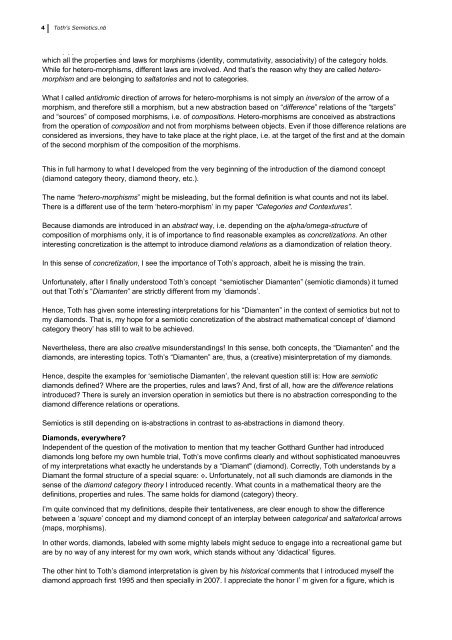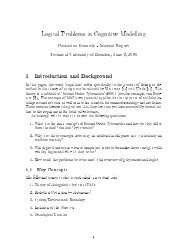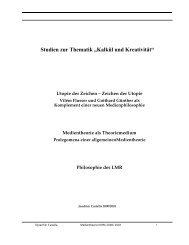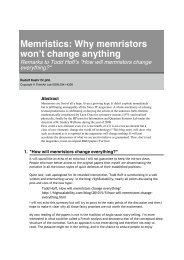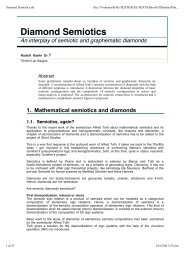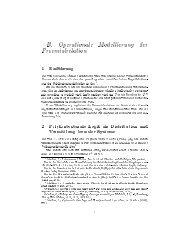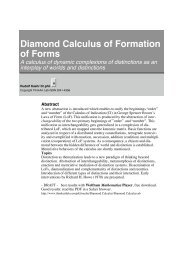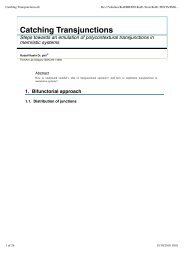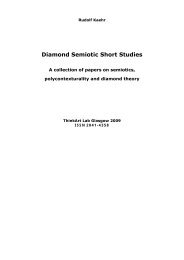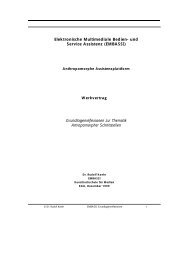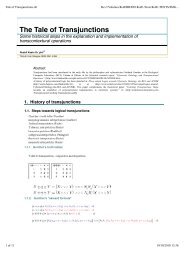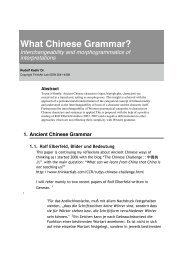Toth's semiotic diamonds - ThinkArt Lab!
Toth's semiotic diamonds - ThinkArt Lab!
Toth's semiotic diamonds - ThinkArt Lab!
You also want an ePaper? Increase the reach of your titles
YUMPU automatically turns print PDFs into web optimized ePapers that Google loves.
That’s a reason too, while Toth’s approach to <strong>diamonds</strong> is important: he offers a concrete interpretation. Hence, it<br />
also could be understood as a model for abstract <strong>diamonds</strong>. On the other hand, <strong>diamonds</strong> are instrumental to<br />
solve some intriguing problems of mathematical <strong>semiotic</strong>s.<br />
4 <strong>Toth's</strong> Semiotics.nb<br />
With my introduction of <strong>diamonds</strong> and their hetero-morphisms I tried to distinguish them from both, inversions and<br />
duals (opposites) of morphisms. It is well known, that an inverted, also dual, morphism is still a morphism for<br />
which all the properties and laws for morphisms (identity, commutativity, associativity) of the category holds.<br />
While for hetero-morphisms, different laws are involved. And that’s the reason why they are called heteromorphism<br />
and are belonging to saltatories and not to categories.<br />
What I called antidromic direction of arrows for hetero-morphisms is not simply an inversion of the arrow of a<br />
morphism, and therefore still a morphism, but a new abstraction based on “difference” relations of the “targets”<br />
and “sources” of composed morphisms, i.e. of compositions. Hetero-morphisms are conceived as abstractions<br />
from the operation of composition and not from morphisms between objects. Even if those difference relations are<br />
considered as inversions, they have to take place at the right place, i.e. at the target of the first and at the domain<br />
of the second morphism of the composition of the morphisms.<br />
This in full harmony to what I developed from the very beginning of the introduction of the diamond concept<br />
(diamond category theory, diamond theory, etc.).<br />
The name “hetero-morphisms” might be misleading, but the formal definition is what counts and not its label.<br />
There is a different use of the term ‘hetero-morphism’ in my paper “Categories and Contextures”.<br />
Because <strong>diamonds</strong> are introduced in an abstract way, i.e. depending on the alpha/omega-structure of<br />
composition of morphisms only, it is of importance to find reasonable examples as concretizations. An other<br />
interesting concretization is the attempt to introduce diamond relations as a diamondization of relation theory.<br />
In this sense of concretization, I see the importance of Toth’s approach, albeit he is missing the train.<br />
Unfortunately, after I finally understood Toth’s concept “semiotischer Diamanten” (<strong>semiotic</strong> <strong>diamonds</strong>) it turned<br />
out that Toth’s “Diamanten” are strictly different from my ‘<strong>diamonds</strong>’.<br />
Hence, Toth has given some interesting interpretations for his “Diamanten” in the context of <strong>semiotic</strong>s but not to<br />
my <strong>diamonds</strong>. That is, my hope for a <strong>semiotic</strong> concretization of the abstract mathematical concept of ‘diamond<br />
category theory’ has still to wait to be achieved.<br />
Nevertheless, there are also creative misunderstandings! In this sense, both concepts, the “Diamanten” and the<br />
<strong>diamonds</strong>, are interesting topics. Toth’s “Diamanten” are, thus, a (creative) misinterpretation of my <strong>diamonds</strong>.<br />
Hence, despite the examples for ‘semiotische Diamanten’, the relevant question still is: How are <strong>semiotic</strong><br />
<strong>diamonds</strong> defined? Where are the properties, rules and laws? And, first of all, how are the difference relations<br />
introduced? There is surely an inversion operation in <strong>semiotic</strong>s but there is no abstraction corresponding to the<br />
diamond difference relations or operations.<br />
Semiotics is still depending on is-abstractions in contrast to as-abstractions in diamond theory.<br />
Diamonds, everywhere?<br />
Independent of the question of the motivation to mention that my teacher Gotthard Gunther had introduced<br />
<strong>diamonds</strong> long before my own humble trial, Toth’s move confirms clearly and without sophisticated manoeuvres<br />
of my interpretations what exactly he understands by a “Diamant" (diamond). Correctly, Toth understands by a<br />
Diamant the formal structure of a special square: Ì. Unfortunately, not all such <strong>diamonds</strong> are <strong>diamonds</strong> in the<br />
sense of the diamond category theory I introduced recently. What counts in a mathematical theory are the<br />
definitions, properties and rules. The same holds for diamond (category) theory.<br />
I’m quite convinced that my definitions, despite their tentativeness, are clear enough to show the difference<br />
between a ‘square’ concept and my diamond concept of an interplay between categorical and saltatorical arrows<br />
(maps, morphisms).<br />
In other words, <strong>diamonds</strong>, labeled with some mighty labels might seduce to engage into a recreational game but<br />
are by no way of any interest for my own work, which stands without any ‘didactical’ figures.<br />
The other hint to Toth’s diamond interpretation is given by his historical comments that I introduced myself the<br />
diamond approach first 1995 and then specially in 2007. I appreciate the honor I’ m given for a figure, which is<br />
known, at least outside polycontexturality, since tausends of years.<br />
In fact, I’m turning around in this carousel at least, officially, since 1973-75 (published 1978), with my closed<br />
proemial relationship ("geschlossene proemial Relation"), which Gunther liked very much, albeit I didn’t see much<br />
to formalize.


